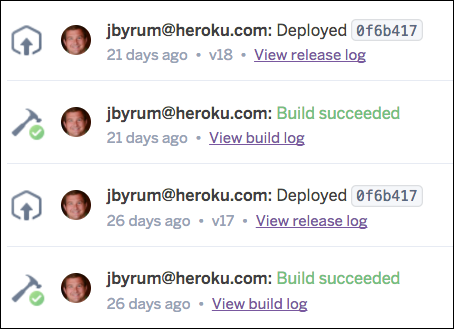Run Tasks with Release Phase
Learning Objectives
After completing this unit, you'll be able to:
- Describe how to set up release phase tasks.
- Describe how to check activity and logs related to releases.
Use the Release Phase
The optional release phase makes it possible to run tasks before you deploy a new release.
Uses Cases
Common tasks executed during this phase include:
- Send CSS, JS, and other assets to a content delivery network (CDN) or AWS S3 bucket.
- Prime or invalidate cache stores.
- Run database schema migrations.
Specify Release Phase Tasks
Your app can use the release process to run release phase tasks in a one-off dyno. To specify tasks, add them to the app’s Procfile. Add a release process type to the file, along with the command to execute.
For example, for a Django app, here's how to specify a database migration in your file:
release: python manage.py migrate
If you deploy Docker images to Heroku, learn more about using the release phase with Container Registry.
When Does the Release Phase Occur?
The release phase tasks execute with each new release, unless the release is caused by changes to an add-on's config vars. All of the following events create a release:
- A successful app build
- A change to the value of a config var
- A pipeline promotion
- A rollback
- A release via the platform API
- Provisioning a new add-on
App dynos don't start for a new release until the release phase finishes successfully. If a release phase task fails, the new release doesn't get deployed.
Roll Back a Release
If you deploy buggy code to production, revert the relevant code changes locally with git revert and redeploy.
If you must roll back a release due to incorrect configuration or other Heroku platform-specific issues, use the heroku rollback command. This command rolls your app back to a previous v40 release:
heroku rollback v40 Rolled back to v40
If you don't specify a release number, your app rolls back by a single release.
The heroku rollback command creates a new release. This release copies the compiled application logic and config vars of the release you're rolling back to.
Check the Release Status
To check on the status of a release, including failed releases and releases that are pending due to a long-running release phase, run heroku releases.
heroku releases === example-app Releases - Current: v52 v53 Deploy ad7c527 release command failed example@heroku.com v52 Deploy b41eb7c example@heroku.com v51 Deploy 38352d3 example@heroku.com
Use the heroku releases:output command to see the output of a particular release phase execution:
heroku releases:output v40 --- Migrating db --- INFO [alembic.runtime.migration] Context impl PostgresqlImpl. INFO [alembic.runtime.migration] Will assume transactional DDL.
Check the Release Logs
Access the logs associated with a release from the Activity tab of your app. Click View release log beside the release you want to view.

Resources
